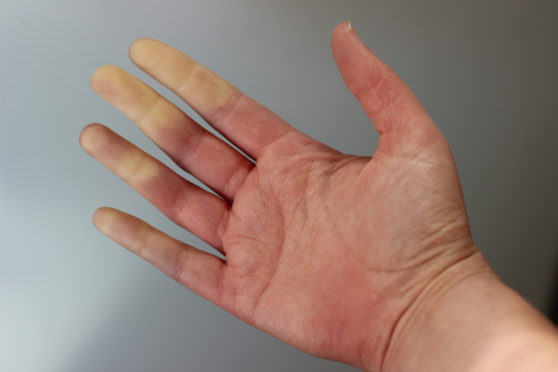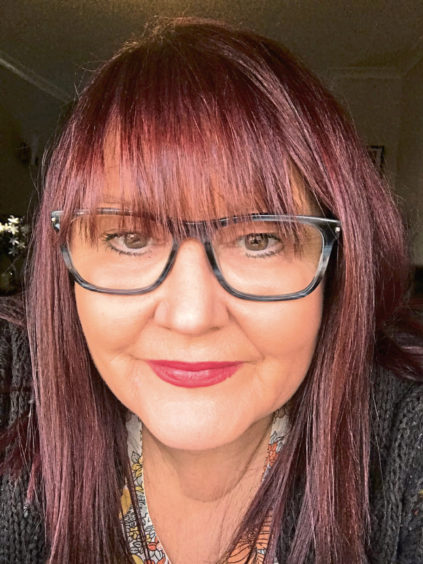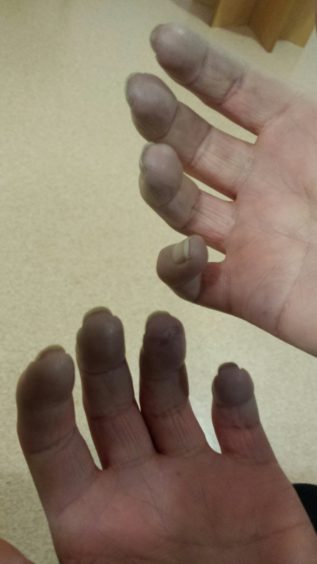
Gillian McNay and Sir Ranulph Fiennes couldn’t be more different.
She’s a Glasgow-based community psychiatric nurse, he’s a polar explorer.
But Gillian understands exactly what drove Fiennes to cut off the frostbitten tips of his fingers with a fretsaw.
You see, she suffers from Raynaud’s and developed gangrene in her fingertip, and admits: “Listen, I’m telling you I was sorely tempted and there were a few nights I could just have taken a knife and cut it off but my doctor just pumped me full of morphine so I didn’t know what day it was!”
Raynaud’s is a condition that affects blood circulation causing some areas of the body, such as fingers and toes, to feel painfully numb or freezing cold in response to changes in temperature.
It can be linked with the more serious scleroderma and affects up to 10 million people in the UK.
“The rheumatologist explained it to me saying ‘It’s your immune system that thinks the area of your body is injured and floods it with anti-inflammatory things, to treat an injury that’s not there,’” says Gillian, who has secondary Raynaud’s which is more likely to cause ulceration or sores.
“I actually lost the tip of my right middle finger. I was in hospital for two weeks having infusions and different tests but the tip was just gangrenous,” she explains.
“It was horrific. I imagined they’d just remove the tip but they said they can’t do that because of the lack of blood supply to the tip, there’s no guarantee the wound would heal, and that I needed to wait for it to ‘auto-amputate’. In other words, wait until it drops off.
“When I was in hospital I was getting the treatment for frostbite because when you first go in you’re under the vascular team in case there’s something wrong with your blood vessels and circulation.
“But they can only give you the infusion in a high-dependency unit and it was a bit debilitating, being stuck on this pump for a week but they throw everything at it to try and save your fingertip.
“When I came out of hospital my finger looked worse but the surgeon was very pleased because he could see a clear line, that the gangrene had stopped and wasn’t travelling any further down.
“It was tremendously sore because it was trapped behind the nail and the pressure was pushing the nail out but I was lucky because my friend and colleague is a podiatrist so she was able to come in and treat it as if it was a toe!
“After I lost my fingertip – I’m right-handed – a lot of everyday things became quite difficult.
“I’ve got ulcers on my other fingers and while they haven’t progressed, they’re extremely painful.
“Because of where I lost the tip of my finger, it’s very sensitive because there’s no padding on the bone.
“It’s difficult to do quite a lot of personal care because you can’t put any pressure on it, like washing your hair or going to the loo.
“Shoes? My God, I’m 55 but I’m not ready for the big slippers yet but I have to wear those shoes with the big Velcro flaps!
“It’s so embarrassing, I wear my trousers long to try and cover them.
“Doing your shopping, passing anywhere that’s cold, everyday things folk take for granted. People are very helpful but you want to do your own stuff.
“Cold and stress are the main triggers. Today’s freezing so I wouldn’t be going out without two or three pairs of gloves on but it could be summer and I’m in trouble because I’m putting out washing, and it’s cold and wet because it’s been lying in the machine.
“All you need is that wee breeze and before you know it your fingers have gone red or white or blue, all numb.
“Any sudden change in temperature will do it. When I go into the shower I put on a pair of non-latex gloves because if my hands get warm in the shower, that starts it off as well.
“The rheumatologist told me to avoid extremes of heat, because sometimes I’d come in and think, ‘Oh, my hands are cold’ and someone would suggest running them under the hot tap which sounds like a good idea but it’s not!
“It came out of the blue, too, a year and a bit ago when I started getting the symptoms but I didn’t go to the doctor because you try to put things off, but it progressed and the gangrene set in.
“I’m really lucky, though, I work for the NHS. Imagine if you worked for a private company and were off for four months, you were a single parent with a mortgage.
“We get sick pay and we’ve been able to make adjustments for me coming back to work – a lot of our work is giving injections and taking blood but I don’t do that any more because I haven’t got the sensitivity to do that.
“That’s OK because I’ve got plenty of other duties. I’m now slow at typing so we’re getting a system where I just speak and it comes up on the screen. They’ve been fantastic.”
February is Raynaud’s Awareness Month. For more information, or to take Scleroderma and Raynaud’s UK’s self-test go to sruk.co.uk/takethetest

Enjoy the convenience of having The Sunday Post delivered as a digital ePaper straight to your smartphone, tablet or computer.
Subscribe for only £5.49 a month and enjoy all the benefits of the printed paper as a digital replica.
Subscribe

